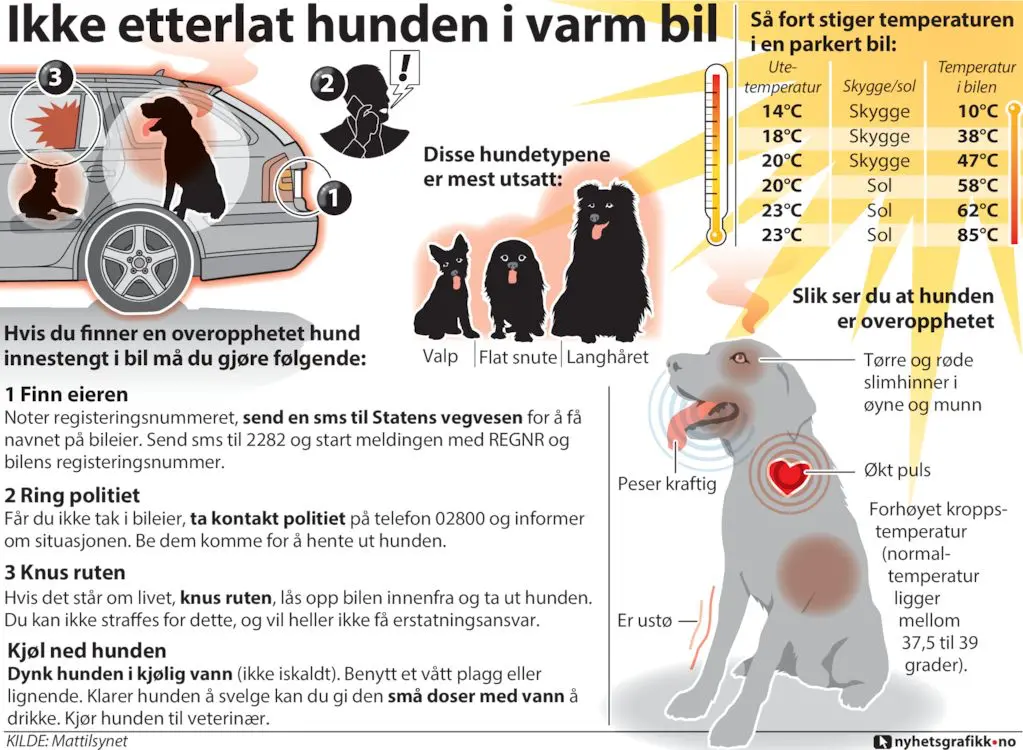Heat stroke in dogs
Heat stroke in dogs
Summer is soon here and in that connection we would like to remind you to think about the animals' safety in the heat. Animals quickly overheat and certain breeds are particularly susceptible. Pugs, bulldogs, shihtzus and other breeds with short snouts are among those that you should take extra care of in the heat. The most important step in the treatment of heat stroke is to actually recognize it.
Dogs don't have sweat glands on their bodies like us humans, except for some under their paws. These sweat glands do not work well to get rid of heat. Dogs pant to cool down in the form of so-called dead space. Air passes through the airways, but no gas exchange takes place. Other risk factors include obesity, a lot of fur and heart disease.
Table of contents
Always have fresh water available
If you are going to be very active, it is recommended to do this in the morning or evening and not when the sun is highest in the sky. Always have fresh water available around the clock. The biggest risk factor is careless owners. Dogs left in hot cars are the most common cause of overheating in dogs.
Symptoms
Dogs are sensitive to heat and can be prone to heat stroke in hot weather or in environments with limited air circulation. Heat stroke is a serious condition that can be life-threatening for your dog, and it is therefore important to be aware of the symptoms. By being aware of the signs, you can quickly react and take the necessary measures to save your dog's life. Here are some common symptoms of heatstroke in dogs:
Excessive panting and heavy breathing: Dogs suffering from overheating will often pant excessively and have difficulty breathing. Breathing may become rapid and audible, and the dog may appear strained.
Red mucous membranes: When the dog becomes overheated, the gums and mucous membranes may turn red or even bluish. This indicates poor oxygen supply and may be a sign.
Laxity and weakness: A dog with heat stroke will often appear weak, lethargic and uninterested in its surroundings. It may have trouble standing or walking, and it may even collapse.
Vomiting and diarrhea: Heat stroke can lead to digestive problems, such as vomiting and diarrhoea. This is because the dog's body is trying to get rid of excess heat.
High body temperature: Dogs normally have a body temperature between 38 and 39,2 degrees Celsius. In heat stroke, the body temperature can rise to dangerous levels, often above 40 degrees Celsius. It is important to note that a dog can have heatstroke even if it does not have an extremely high temperature.
If you suspect your dog may be suffering from heatstroke, it is important to act quickly. First of all, you need to move the dog to a cooler area with shade and good air circulation. Give it access to fresh and cold water, but avoid forcing it to drink. Try to cool the dog down gently by placing damp, cold towels or ice packs on his stomach, groin and paws. You should immediately contact your veterinarian for professional help and guidance.
Remember that this is a potentially life-threatening condition, and prevention is always better than cure. Avoid leaving the dog outside in extreme heat, give it plenty of shade and fresh water, and avoid exercising or activating it in the heat. Pay attention to your dog's well-being and symptoms to ensure his health and safety.
| Time | Temperature outside | Shade/sun | Temperature in car | |
|---|---|---|---|---|
| 08.30 | 14°C | Shade | 19°C | |
| 09.30 | 18°C | Shade | 38°C | |
| 10.30 | 20°C | Mixed | 47°C | |
| 11.30 | 20°C | SOL | 58°C | |
| 12.00 | 23°C | SOL | 62°C | |
| 13.30 | 22°C | SOL | 85°C |
Signs of heatstroke
As they become more overheated, they will experience heat stroke. Then the animal may collapse, lose its balance or lose consciousness. The most important step in treatment is to actually recognize it. Then you or others present contact a vet while you start to cool the animal down, but don't cool down too quickly! Always start by removing the animal from the hot zone, find shade and preferably an area that is ventilated.
Elisabeth is a veterinarian and authorized ophthalmologist with specialization in eye surgery, as well as further training in internal medicine, general surgery, oral surgery and ultrasound from the European School for Advanced Veterinary Studies in Toulouse.
-
Elisabeth Bjørnestadhttps://www.a-vet.no/author/elisabeth_bjornestad/
-
Elisabeth Bjørnestadhttps://www.a-vet.no/author/elisabeth_bjornestad/
-
Elisabeth Bjørnestadhttps://www.a-vet.no/author/elisabeth_bjornestad/
-
Elisabeth Bjørnestadhttps://www.a-vet.no/author/elisabeth_bjornestad/



